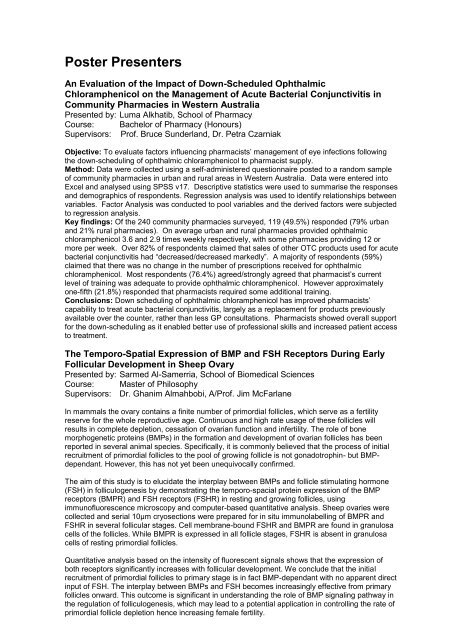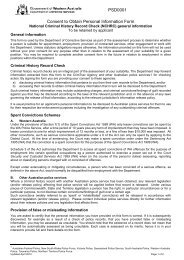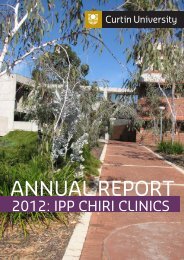Faculty Of Health Science The Mark Liveris Health Science
Faculty Of Health Science The Mark Liveris Health Science
Faculty Of Health Science The Mark Liveris Health Science
Create successful ePaper yourself
Turn your PDF publications into a flip-book with our unique Google optimized e-Paper software.
Poster PresentersAn Evaluation of the Impact of Down-Scheduled OphthalmicChloramphenicol on the Management of Acute Bacterial Conjunctivitis inCommunity Pharmacies in Western AustraliaPresented by: Luma Alkhatib, School of PharmacyCourse: Bachelor of Pharmacy (Honours)Supervisors: Prof. Bruce Sunderland, Dr. Petra CzarniakObjective: To evaluate factors influencing pharmacists’ management of eye infections followingthe down-scheduling of ophthalmic chloramphenicol to pharmacist supply.Method: Data were collected using a self-administered questionnaire posted to a random sampleof community pharmacies in urban and rural areas in Western Australia. Data were entered intoExcel and analysed using SPSS v17. Descriptive statistics were used to summarise the responsesand demographics of respondents. Regression analysis was used to identify relationships betweenvariables. Factor Analysis was conducted to pool variables and the derived factors were subjectedto regression analysis.Key findings: <strong>Of</strong> the 240 community pharmacies surveyed, 119 (49.5%) responded (79% urbanand 21% rural pharmacies). On average urban and rural pharmacies provided ophthalmicchloramphenicol 3.6 and 2.9 times weekly respectively, with some pharmacies providing 12 ormore per week. Over 82% of respondents claimed that sales of other OTC products used for acutebacterial conjunctivitis had “decreased/decreased markedly”. A majority of respondents (59%)claimed that there was no change in the number of prescriptions received for ophthalmicchloramphenicol. Most respondents (76.4%) agreed/strongly agreed that pharmacist’s currentlevel of training was adequate to provide ophthalmic chloramphenicol. However approximatelyone-fifth (21.8%) responded that pharmacists required some additional training.Conclusions: Down scheduling of ophthalmic chloramphenicol has improved pharmacists’capability to treat acute bacterial conjunctivitis, largely as a replacement for products previouslyavailable over the counter, rather than less GP consultations. Pharmacists showed overall supportfor the down-scheduling as it enabled better use of professional skills and increased patient accessto treatment.<strong>The</strong> Temporo-Spatial Expression of BMP and FSH Receptors During EarlyFollicular Development in Sheep OvaryPresented by: Sarmed Al-Samerria, School of Biomedical <strong>Science</strong>sCourse: Master of PhilosophySupervisors: Dr. Ghanim Almahbobi, A/Prof. Jim McFarlaneIn mammals the ovary contains a finite number of primordial follicles, which serve as a fertilityreserve for the whole reproductive age. Continuous and high rate usage of these follicles willresults in complete depletion, cessation of ovarian function and infertility. <strong>The</strong> role of bonemorphogenetic proteins (BMPs) in the formation and development of ovarian follicles has beenreported in several animal species. Specifically, it is commonly believed that the process of initialrecruitment of primordial follicles to the pool of growing follicle is not gonadotrophin- but BMPdependant.However, this has not yet been unequivocally confirmed.<strong>The</strong> aim of this study is to elucidate the interplay between BMPs and follicle stimulating hormone(FSH) in folliculogenesis by demonstrating the temporo-spacial protein expression of the BMPreceptors (BMPR) and FSH receptors (FSHR) in resting and growing follicles, usingimmunofluorescence microscopy and computer-based quantitative analysis. Sheep ovaries werecollected and serial 10µm cryosections were prepared for in situ immunolabelling of BMPR andFSHR in several follicular stages. Cell membrane-bound FSHR and BMPR are found in granulosacells of the follicles. While BMPR is expressed in all follicle stages, FSHR is absent in granulosacells of resting primordial follicles.Quantitative analysis based on the intensity of fluorescent signals shows that the expression ofboth receptors significantly increases with follicular development. We conclude that the initialrecruitment of primordial follicles to primary stage is in fact BMP-dependant with no apparent directinput of FSH. <strong>The</strong> interplay between BMPs and FSH becomes increasingly effective from primaryfollicles onward. This outcome is significant in understanding the role of BMP signaling pathway inthe regulation of folliculogenesis, which may lead to a potential application in controlling the rate ofprimordial follicle depletion hence increasing female fertility.





![Mental health commission report July 2010 - June 2011 [.pdf]](https://img.yumpu.com/50755705/1/184x260/mental-health-commission-report-july-2010-june-2011-pdf.jpg?quality=85)











![2007 Annual Report [.pdf] - Health Sciences - Curtin University](https://img.yumpu.com/44476724/1/184x260/2007-annual-report-pdf-health-sciences-curtin-university.jpg?quality=85)